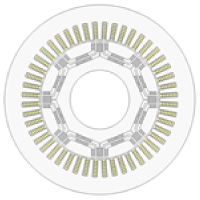Contents
1. Introduction
2. Optimization of a PMSM
3. Sensitivity study
3.1 Design variable range
3.2 Population size
3.3 FEA model fidelity
4. Summary
1. Introduction
The feasible solution space of large scale multi-objective optimization schemes is sensitive to the configuration (population size, objectives, constraints, and design variables). This report analyzes the sensitivity of the feasible solution space to the configuration parameters in the design optimization of a permanent-magnet synchronous machine. “Configuration sensitivity” is key to computational efficiency especially where multiple objectives and constraints apply, where the number of design variables is large, and where diverse technologies are required in the design process — as, for example, in automotive electrification where experienced-based design is limited.
2. Optimization of a PMSM
An optimization problem is defined for a 8 poles 48 slots PMSM as shown in Fig. 1. The overall objective is to find optimal current vector strategies and rotor geometries that satisfy the detailed objectives and constraints in Table 1. The number of the geometrical design variable is 20. The feasible solution area is shown in Fig. 2. In the optimization, the configuration is the maximum one which consists of widest ranges for design variables, the largest population size and the highest fidelity of FEA model as described in the following sections. The feasible solution space is quite small due to severe objectives and constraints.

Fig. 1 Motor topology
Table 1 Objective functions and constraints
| Objective functions | Constraints | |
| Torque | Maximize | >100 (Nm) (low speed) >30 (Nm) (high speed) |
| Torque ripple rate | Minimize | >0.35 |
| Loss | Minimize | >1,200 (W) (low speed), >3,000 (W) (high speed) |
| Voltage | Minimize | >300 (V) |
| Stress | Minimize | >200 (MPa) |
It shows an initial motor geometry of the IPMSM to be optimized. The machine has 8 poles, 48 slots with two layers of magnets. The design variables in the optimization are 20 dimensions, and 4 for current amplitudes, and phases both at low and high speeds
You need to sign in as a Regular JMAG Software User (paid user) or JMAG WEB MEMBER (free membership).
By registering as a JMAG WEB MEMBER, you can browse technical materials and other member-only contents for free.
If you are not registered, click the “Create an Account” button.
Create an Account Sign in



